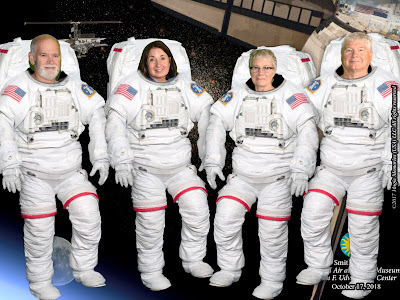For several years we've been talking about returning to Washington DC to see some of the newer museums that have been built since we took the kids in the late 1980's. We leave from San Francisco (SFO) and are pleasantly surprised by some of the airport's renovations, including decent restaurants, dog areas and even a Yoga room to relax between flights.
 |
| New control tower worthy of the space age |
|
 |
| Circling around we get wonderful views of the city |
|
|
 |
| Flying over the desert southwest |
|
 |
| Rocky Mountains at sunset |
|
|
We are fortunate to be staying at Peter's nephew Jonathan's home where his sister Jill and her husband Mark are already waiting for us. The next morning, Jono suggests we start at the
Udvar-Hazy Space Museum which is close to Dulles Airport. This is no small everyday museum. It consists of several enormous hangars chock full of aircraft from the dawn of aviation to the space shuttle. All the aircraft are restored originals. Eventually, they plan to move the whole
downtown DC Air and Space Museum into this location.
 |
| Entrance to the Udvar-Hazy Space Museum |
|
|
 |
| Wow - this place is gigantic! |
|
As we enter, we are greeted by the
Lockheed SR-71 Blackbird. It was developed in the 1960's for the Air Force. It was used for long-range high-altitude reconnaissance from 1964 to 1998 and remains to this day as the fastest air-breathing manned aircraft. Besides its odd shape designed to evade radar detection, the outer shell is made of titanium which was ironically sourced from Russia. It's believed to have been the basis of multiple UFO sightings during it's test flights over the American deserts.
 |
| From this angle it looks like a large flat pancake |
|
 |
| UFO appearance |
|
 |
| Enormous side jet engine |
|
From the Blackbird, we move onto the antique airplane section. In comparison, these flying machines seem a little more than bicycles with wings and an engine, which pretty much describes the Wright Brothers original plane. Their original Kitty Hawk plane is still housed in the downtown DC museum. Not all of these early efforts actually succeeded in flying. For more on the Wright Brothers and early planes read David McCullough's excellent book
The Wright Brothers.
 |
| Early plane showing it's evolution from bicycles |
|
 |
| Inspired by dragonflies? |
|
 |
| This early French plane broke apart before getting airborne |
|
Of course, there's a large assortment of World War II era planes. One of the most outstanding is the
Enola Gay, a Boeing B-29 Superfortress bomber which dropped the first atomic bomb on August 6, 1945 on Hiroshima, Japan and then later on Nagasaki leading to the unconditional surrender of Japan and the end of WWII. However, it also opened the Pandora's Box of the atom.
After WWII air craft quickly evolved into all kinds of shapes, sizes and purposes.
 |
| Single engine plane used for advertising |
|
|
|
The
Concorde was first supersonic airliner (and as far as I know the last) catered to a first class clientele. In it's day it flew twice as fast as any other passenger plane. However it was expensive to operate and tickets cost a premium.
One hangar in the complex is devoted entirely to the restoration of aircraft. Unfortunately, this area was closed the day we visited, but it looks like they work on an interesting array of projects.
Of course this museum has a space shuttle and we are able to suit up and enjoy the ride (with the help of photoshop).
We wrapped up our visit watching the movie
First Man at the museum's Omni Max Theater. It was a fitting end to a wonderful day.





























Awe inspiring; would love to get there sometime!
ReplyDelete